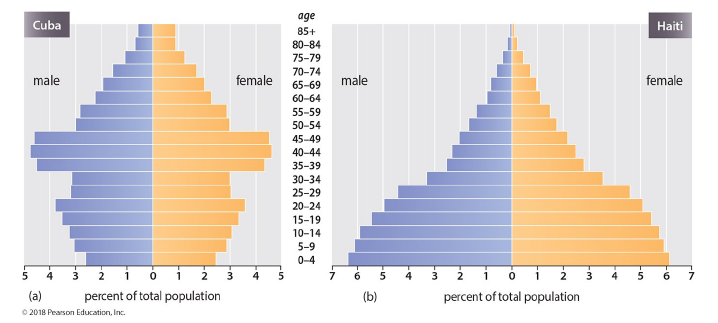Compare the population pyramid of Haiti to that of Cuba. What trends are evident and accounts for these?

What will be an ideal response?
Although neighbors, Cuba and Haiti have extremely different population profiles. Cuba's population is stable and older, with a notable decline in family size. Haiti's population is much younger and growing, which is reflected in its broad-based pyramid. Although both are poor Caribbean countries, Haiti has the more classic, broad-based pyramid of a developing country, where more than one -third of the population is under the age of 15. Also, there are very few old people, due to the relatively low life expectancy in Haiti. In contrast, Cuba's population pyramid is more diamond-shaped, bulging in the 35- to 49-year-old age cohort and tapering down after that. Here the impact
of the Cuban revolution and socialism is evident. Family size came down sharply after education improved and modern contraception became readily available. With better health care, Cuba's population also lives longer, having nearly the same life expectancy as those in the United States. Cuba has 12 percent of its population over 65 and just 17 percent under 15; thus, it has an extremely low rate of natural increase, similar to many developed countries in the world.
You might also like to view...
Between the years 1955 and 2011, the total fertility rate in the world
a. increased from 2.8 to 6.5 b. decreased from 5.0 to 2.5 c. decreased from 2.5 to 1.6 d. increased from 1.6 to 2.5 e. increased from 2.5 to 2.8
The figure below shows a ray of white light striking a glass prism and dispersing into its component colours. Which of the rays has the shortest wavelength?

A. ray B B. ray C C. ray D D. ray E
What drives a storm surge ashore?
A) Frontal storms B) Wind C) Gravity D) Currents
Which of the following applies to the labeling of most packaged foods in the U.S.?
A) Each manufacturer determines what to put on the label. B) Labeling requirements are set by each state. C) Labeling requirements are set by the federal government. D) Labeling requirements are set by the World Health Organization.